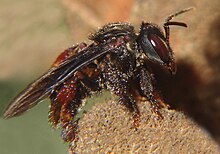Trigona (bee)
| Trigona | |
|---|---|
 |
|
| Trigona spinipes | |
| Scientific classification | |
| Kingdom: | Animalia |
| Phylum: | Arthropoda |
| Class: | Insecta |
| Order: | Hymenoptera |
| Family: | Apidae |
| Tribe: | Meliponini |
| Genus: |
Trigona Jurine, 1807 |
| Subgenera | |
|
Duckeola |
|
Duckeola
Frieseomelitta
Geotrigona
Heterotrigona
Homotrigona
Lepidotrigona
Papuatrigona
Tetragonula
Tetragonisca
Trigona
Trigona is the largest genus of stingless bees, formerly including many more subgenera than the present assemblage; many of these former subgenera have been elevated to generic status.Trigona are oval-shaped creatures with golden-yellow and brown bands. Almost all Trigona bees have varying dark-to-light striations. Trigona are three to five millimeters in size, and have a slimmer body in total variance.
Trigona species occur throughout the Neotropical region, including South and Central America, the Mexican lowlands, and the Caribbean islands. They can occur in forests, savannas, and man made environments. Trigona bees are active all year round, although they are less active in cool environments.
Trigona bees nests are constructed from wax they produce and plant resins they collect. They usually nest in hollow trunks, tress branches, and underground.
Vulture bees consist of three Trigona species that are the only known bees not to be herbivores. These bees collect and eat meat.
Some species of Trigona bees use saliva to lay scent trails guiding nest mates to a food source. Some species of Trigona use eavesdropping which help them detect food sources being exploited by competitors.
Eucalyptus seeds adhere to resin in the workers corbiculae and can be transported to the nest. Workers transported seeds distance of more than three hundred meters; seeds at the nest were viable and capable of germination.
...
Wikipedia
